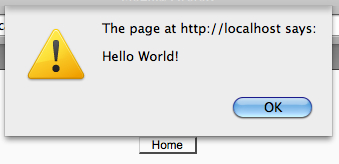Now that we have loaded our JavaScript file, we need a method to execute that code. Once again, we may use the Page Requirements Manager $PAGE to generate a call to our JavaScript function.
Note
This recipe describes a basic technique for executing your JavaScript code when the page is loaded. More sophisticated techniques based on handling DOM events with the Yahoo! User Interface library will be covered in later chapters.
Set up a page requirejs_init.php with the following content:
<?php
require_once(dirname(__FILE__) . '/../config.php');
$PAGE->set_context(get_context_instance(CONTEXT_SYSTEM));
$PAGE->set_url('/cook/requirejs_init.php');
$PAGE->requires->js('/cook/requirejs_init.js');
$PAGE->requires->js_init_call('hello');
echo $OUTPUT->header();
echo $OUTPUT->footer();
?>
Set up the accompanying JavaScript file, requirejs_init.js, with the following content:
function hello(Y)
{
alert('Hello World!');
}
Now when we load the page, we see that our JavaScript alert is executed, assuring us that our code is loading and executing correctly, as seen in the following screenshot:




